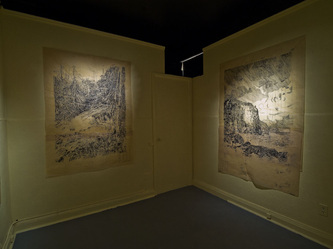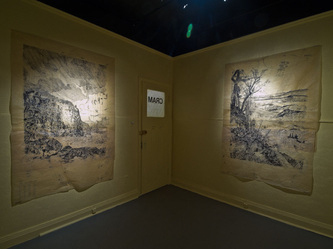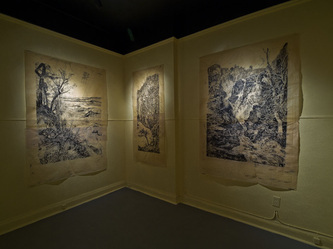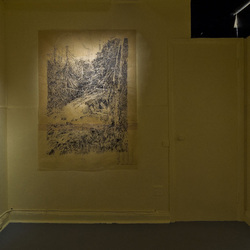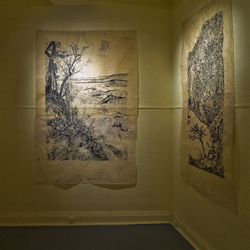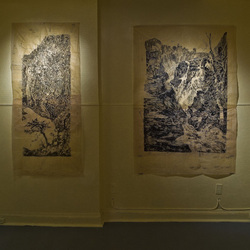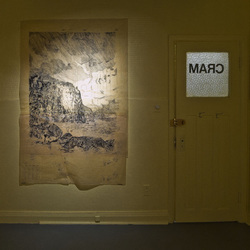Carolyn Wren
June 1 – June 19, 2012
Using old images from 19th century etchings, Wren plays with the ideas of veneration of the landscape and art itself. Like all museum experiences, the viewer enters and is hushed by the reverence and reverie of art. Similarly, the same charged visual experience is felt when looking at a luminous vista. This conflation of landscape, art, and spirituality is not new; it is borrowed from philosophers and artists who have been studying this phenomenon for centuries. Yet Wren adds a new dimension to the mix. She subtly introduces the human element through her choice of material. The pattern pieces used for sewing are the base on which she draws and prints. The landscape, at first glance, appears to be untouched; nature stands alone, wild, and untamed in all its glory. Upon closer observation, the trace of the body is revealed, folded into the landscape through the use of the contour lines in the pattern pieces. In the sublime, humanity stands in the centre of the landscape to observe nature’s beauty and horror. Without the body (and its brain), there would be nature; the sublime exists only in the observer. In Immanuel Kant’s Critique of Judgment of 1790, he states, “when we speak of the sublime in nature we speak improperly; properly speaking, sublimity can be attributed merely to our way of thinking…” Through the omission of the figure, Wren underscores the power of the landscape in all its beauty and terror. In some of her pieces the viewer responds by yearning for days gone by or hoping for a better future – actions of the past or future.
June 1 – June 19, 2012
Using old images from 19th century etchings, Wren plays with the ideas of veneration of the landscape and art itself. Like all museum experiences, the viewer enters and is hushed by the reverence and reverie of art. Similarly, the same charged visual experience is felt when looking at a luminous vista. This conflation of landscape, art, and spirituality is not new; it is borrowed from philosophers and artists who have been studying this phenomenon for centuries. Yet Wren adds a new dimension to the mix. She subtly introduces the human element through her choice of material. The pattern pieces used for sewing are the base on which she draws and prints. The landscape, at first glance, appears to be untouched; nature stands alone, wild, and untamed in all its glory. Upon closer observation, the trace of the body is revealed, folded into the landscape through the use of the contour lines in the pattern pieces. In the sublime, humanity stands in the centre of the landscape to observe nature’s beauty and horror. Without the body (and its brain), there would be nature; the sublime exists only in the observer. In Immanuel Kant’s Critique of Judgment of 1790, he states, “when we speak of the sublime in nature we speak improperly; properly speaking, sublimity can be attributed merely to our way of thinking…” Through the omission of the figure, Wren underscores the power of the landscape in all its beauty and terror. In some of her pieces the viewer responds by yearning for days gone by or hoping for a better future – actions of the past or future.

